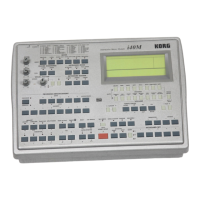Getting Started • Operative modes
15
3. Operative modes
The instrument can function in different “modes”,
each of which groups together functions that are for its
own particular use. In order to choose a mode you
need to press a button in the MODE section.
Arrangement Play mode
Arrangement Play is the main operative mode. When
the instrument is turned on, it is always in this mode,
where you can select the arrangements and the Key-
board Set you wish to use.
There are 192 arrangements in total, organized as 64
arrangements in each of the three banks A, B, and
USER. The arrangements in the USER bank are freely
modifiable and can be used to load new data from a
disk.
The 15 Keyboard Set are all freely modifiable and
divided in three banks with 5 Keyboard Set each. The
Keyboard Set are designed to immediately change the
programs of the real time tracks and the settings of the
VOCAL/GUITAR section.
Each arrangement is composed of a style and three
real time tracks (Upper 1, Upper 2, and Lower). The
real time tracks can be played “live” with the accom-
paniment of the style tracks.
The way in which the real time tracks are arranged on
a MIDI keyboard and their activation/deactivation
state are set in the KEYBOARD MODE and KEY-
BOARD ASSIGN sections.
The styles are made up of patterns (musical structures)
used to create the automatic accompaniments. Each
style contains four variations, two intros (introduc-
tions), two endings and two fill-ins (passages).
The style selected by the arrangement detects the type
of chord played in a section known as “chord detec-
tion section” and adapts its pattern to that chord. For
example, if the pattern is in C major, playing a F major
chord in the chord detection section will cause the pat-
tern transposition to F major.
The way in which patterns are affected by chords is of
course more complex than what indicated above. Korg
instruments are renowned for their refinement in
detecting the chords.
The styles consist of six tracks: drums, percussion,
bass, accompaniment tracks ACC1, ACC2 and ACC3.
These six tracks are referred to as the Backing Tracks,
since they provide the rhythmical and harmonic back-
ing of the song.
Whilst playing you can modify several arrangement
parameters (e.g. the volume of the instrumental parts),
however if you stop the accompaniment, or decide to
select a different arrangement, your edits will be lost.
To save the changes in the USER bank use the Write
Arrangement of the “Page 24: Write Arrangement”
(see page 79).
To save the changes in the Keyboard Set use the Write
Keyboard Set function of the “Page 25: Write Key-
board Set” (see page 80).
The following scheme shows the parameters that are
automatically changed when selecting an arrangement
or Keyboard Set:
• if the SINGLE TOUCH led is on, the arrangement
can also change the parameters of the real time
tracks;
• if the SINGLE TOUCH led is off, the arrangement
can only change the parameters of the accompani-
ment tracks.

